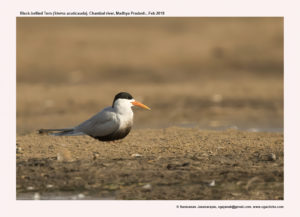Black-bellied tern
Black-bellied Tern Sterna acuticauda
Etymology :
- Sterna : Old English name “stearn” for terns , believed to be derived from Danish and Norwegian terne or Swedish tärna
- Acuticauda : Latin word acutus – sharp,pointed; caudatus- tailed
Vernacular Name: Pun: Kali taheri, Guj: Kalapetnidhomdi, Kalapethvabagali, Te: Ramadasu, Mal: Karivayaranala, Mar: KalyaPotachasuray
Distribution in India: Widespread resident in North, Central and West India and winter visitor in Kerala.
Description: Size of 32–35 cm. It has a black cap and grey back and long and pointed grey wings..The throat is white, breast is pale grey shading into deep black and belly is brownish-black similar to undertail-coverts. The dark underparts contrast with white underwing, latter with darker band across secondaries. The bill is yellow-orange and legs are reddish orange. The non-breeding adult has white forecrown streaked with black, black band behind eye, whitish underparts, mottled black on belly, and black tip to bill. The juvenile has red at base of mandible and blackish feet.
Habitat: It is found in inland lakes and rivers, preferring broad, barren, featureless flats, sand spits and sandy islands in rivers. It is found from lowlands up to 700 m.
Food habits: It eats insects like dragonflies and small fish. It forages along rivers and lakes, and over paddies, ditches and village ponds. It plunge-dives for fish, and aerial-dips for insects over water and land. Despite non-colonial breeding, feeds in flocks. .
Breeding habits: They breed in Feb–May. Early nests are flooded. . The nest is a shallow, unlined scrape in bare sand. They lay a clutch of 2-3 eggs. The incubation period is 15–16 days and fledgling period is eight weeks. The adults shade the eggs and chicks, and also sprinkle water from belly feathers and the adults also mob intruding birds and predators.
